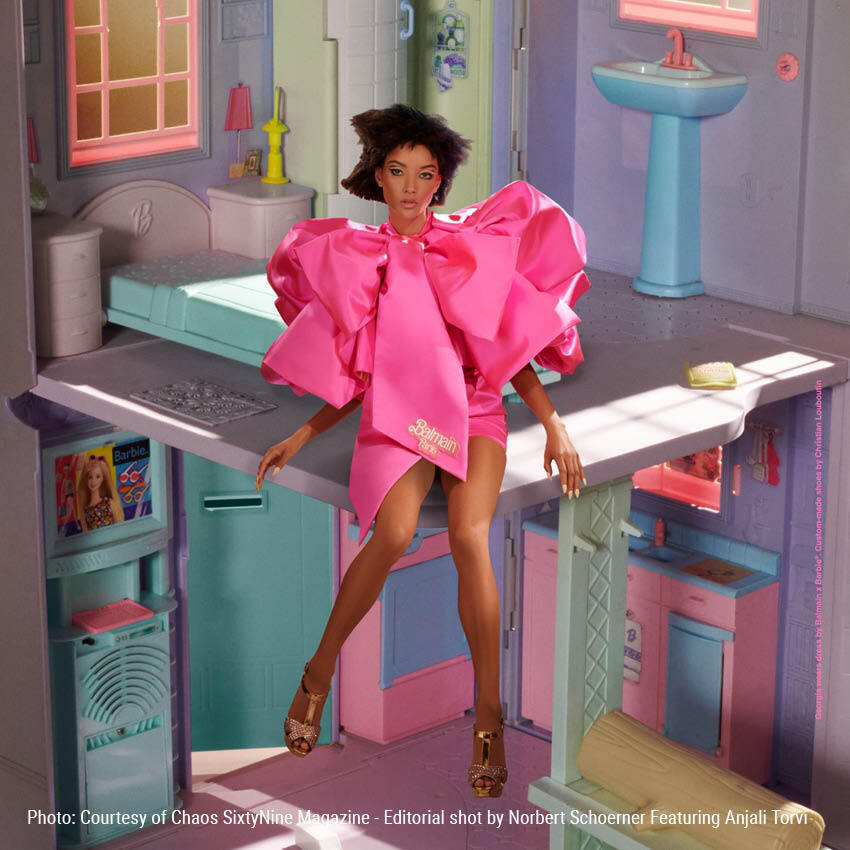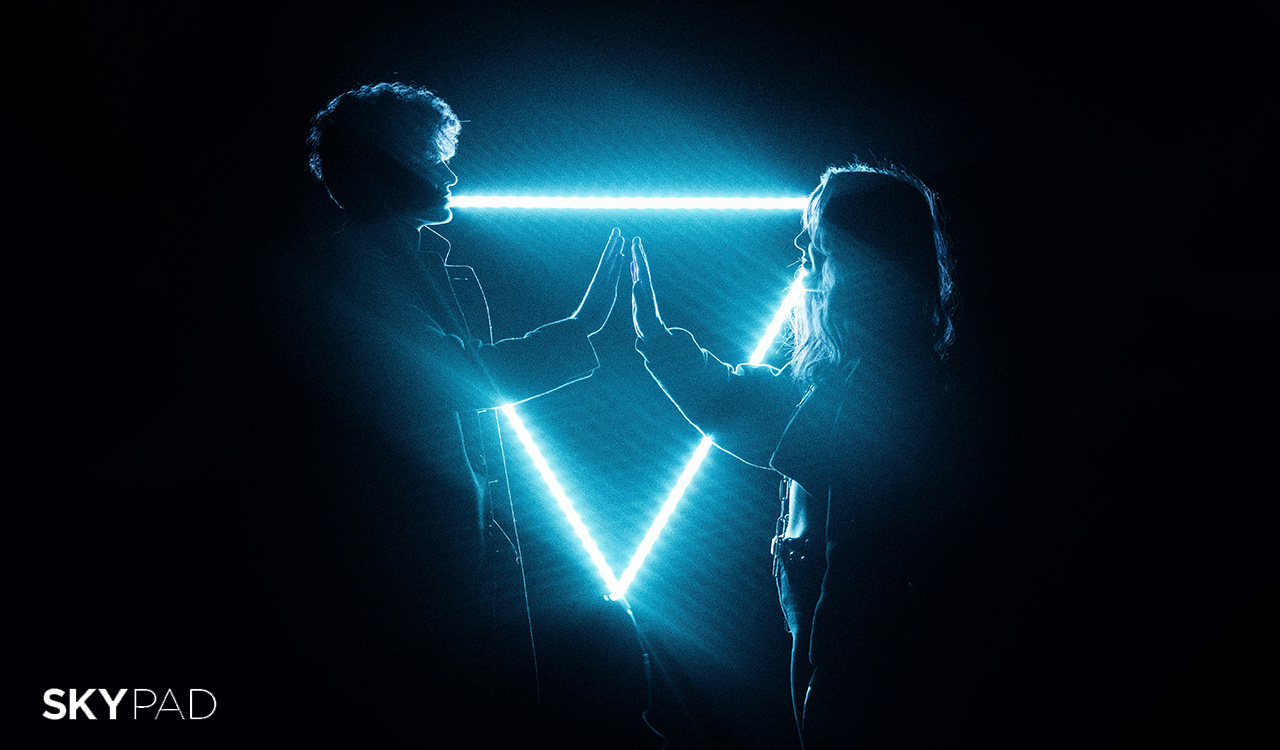Barbie may have struggled with math in the 1990s, but now she is minting NFT’s and logging some entries to the blockchain. Barbie’s latest luxury collaboration is with Balmain, but don’t expect to find a decked-out plastic doll in the new Macy’s-ified TOYS”R”US. If this Barbie is your desire, Mattel is holding an online auction where you can bid on a digitized one-of-a-kind replicant, with a doll-sized equivalent of the clothes to dress your own Barbie if you place the winning bid. There are three Barbie/NFT items being auctioned. The site describes one NFT as, “A stylish avatar wearing a striped sweater dress with a shoulder cut-out and carrying a pink maxi pillow bag featuring Balmain’s signature monogram and BALMAIN X BARBIE logo.” If you need an life size IRL, very pink fashion fix, the BALMAIN X BARBIE capsule collection of unisex garments ranging in price from $295 to $42,000 is currently for sale at the BALMAINXBARBIE site and other retailers.
The 3 BALMAIN X BARBIE NFT’s closed at $12,490, $14,786, and $21,379. These valuations dwarf the previously eye-popping amount recorded when Gucci auctioned an NFT handbag that only exists in the Roblox gaming platform for 350,000 Robux, the game’s exclusive currency, which translates to $4,115.
NFTs
If you have tuned out at the mention of NFTs, you should probably read this article. I believe the current iteration of fashion and certainly mass-market toy NFTs represents a fad, but NFTs are an element of exchange that will gain utility in the metaverse and/or the nominally decentralized Web 3.0 when they are mainstreamed. Reuters recently reported that NFT sales hit $25 billion in 2021. Real money is currently at play, albeit for not-very-useful items beyond the current gaming-based meta-economy … and bragging rights.
Essential Definitions
- A fungible good is something that can be duplicated with no diminution of value, e.g., the U.S. Treasury can make an identical duplicate of the quarter in my wallet, the copy in your wallet has an equal value to mine, while my own quarter will still get me ten minutes at a parking meter.
- A non-fungible good represents an item that is distinct with a singular value. A non-fungible object can be duplicated, just as an image of Van Gogh’s Starry Night may appear on that coffee mug in your cabinet, but the value of the original object is not diminished by the process of duplication, and the value is not shared with the facsimile.
- A smart contract represents an agreement between a buyer and seller that is generated and registered digitally in a verifiable blockchain network.
- A non-fungible token (NFT) is a blockchain housed identifier (or piece of individual code) that represents the terms of a smart contract that were granted upon the exchange of a singular digital object. This object could be a virtual property owned in a specific online-only environment (Decentraland), a digitally generated image of Barbie decked out in Barbie-sized Balmain attire, or the $69 million digital artwork by Beeple that was sold by Christie’s in 2021.
Value Proposition
The BALMAIN X BARBIE NFT’s closed at $12,490, $14,786, and $21,379. These valuations dwarf the previously eye-popping amount recorded when. Gucci auctioned an NFT handbag that only exists in the Roblox gaming platform. The bag banked 350,000 Robux, the game’s exclusive currency, which translates to $4,115. Jimmy Choo, Burberry, Tommy Hilfiger, and others have joined an already thriving business of in-game apparel and bling sales of NFTs in Fortnight, Animal Crossing, Roblox, and other gaming platforms. Statista’s analysis pegged the 2020 in-video game spending at over $54 million and projects an increase to nearly $75 million by 2025.
You might ask since an NFT is a bit of code that represents an object that only exists digitally, what is the tangible value exchange? One answer is, if a market exists that applies value to an object, that applied value can be exchanged for currency when sold. The concept of an NFT’s value analogizes to that of cryptocurrency. The strategic analyst, podcaster, and author of the subscription newsletter Stratchery Ben Thompson tackled a similar question when explaining the value of Bitcoin in 2017. Thompson wrote, “Bitcoin has been around for eight years now, it has captured the imagination, ingenuity, and investment of a massive number of very smart people, and it is increasingly trivial to convert it to the currency of your choice. Can you use Bitcoin to buy something from the shop down the street? Well, no, but you can’t very well use a piece of gold either, and no one argues that the latter isn’t worth whatever price the gold market is willing to bear. Gold can be converted to dollars which can be converted to goods, and Bitcoin is no different. To put it another way, enough people believe that gold is worth something, and that is enough to make it so, and I suspect we are well past that point with Bitcoin.” In a recent article Thompson applied his earlier comments to NFTs, “Bitcoin’s value is rooted not in the Bitcoin blockchain, but rather in the collective belief of millions that it is in fact valuable; NFTs, to the extent they capture and retain value, will require the same sort of collective belief. That means the real power is not the record of belief, but rather the ability to inspire belief in the first place.”
Marketplaces
The number of believers is growing, buffeted by a general understanding of crypto-currency and an increasing acceptance of crypto-valuations. Additionally, the technological systems developed to support the creation and sale of NFTs are a driving force. NFT marketplaces have flourished, some of them aligned with sports leagues (NBA), some are specifically developed for digital art sales, but much of the energy surrounding the more general exchange of NFT’s is coalescing at OpenSea, a user-friendly site that has the feel of an Etsy for NFTs. Devin Finzer, the Co-Founder and CEO of OpenSea, penned the NFT Bible in 2020. It is an easy-to-digest explanation and gateway to NFT engagement. OpenSea had a recent Series C fundraising round and is now valued at $13.3 billion.
A Retail Perspective
This is a frothy moment for NFTs as the overlap between physical and digital goods increases. A flurry of patent applications filed in December 2021 imply that Walmart is actively exploring an NFT-stocked virtual commerce channel and a digital token (a form of cryptocurrency). CNBC reporting suggests that the filings “show it intends to make and sell virtual goods such as electronics, decor, toys, sporting goods and personal-care products.” Bloomberg News reports that the company intends to create virtual iterations of ecommerce fulfillment practices noting that among the filings were three trademark applications for shopping services named “Verse to Curb, Verse to Store, and Verse to Home.” Other examples include Samsung’s January 2022 announcement heralding its NFT marketplace. The marketplace sells virtual artworks for display on the latest Samsung TV models, newly optimized to vividly exhibit the works.
For retailers and brands with an affinity for experimentation, NFTs can be a step toward digital goods fluency as the market emerges. If a collective belief in the value of NFTs continues to grow, that is something we in retail could all believe in.




